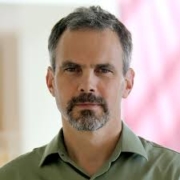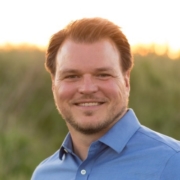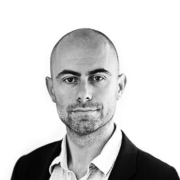Teach For America developed an alternative teacher education model that spread not only around the United States but also across the world.
My guest today is Rolf Straubhaar, Assistant Professor of Educational Leadership and School Improvement at Texas State University. In his latest article in the Journal of Teacher Education, Rolf looks at the Teach For All affiliate in Brazil called Ensina! In our conversation, Rolf explores the history of TFA, the motivation of people to join the program, and how their perspectives changed over time.
Citation: Straubhaar, Rolf, interview with Will Brehm, FreshEd, 176, podcast audio, October 14, 2019. https://www.freshedpodcast.com/rolfstraubhaar/
Transcript, Translation, and Resources:
Will Brehm 1:55
Rolf Straubhaar, welcome to FreshEd.
Rolf Straubhaar 1:57
Thanks, Will. Glad to be here.
Will Brehm 1:58
I don’t know if many listeners know, but you actually were host of this show for maybe three or four episodes, like three or four years ago. So welcome back on, for a show to actually highlight your own research.
Rolf Straubhaar 2:12
Thank you. Yeah, that was a fun little interim where back at the time I was leading the committee within CIES’s Globalization and Education SIG. We had done a Book Award, and so we did a short series highlighting the winner and a couple of the runners up. It was fun.
Will Brehm 2:30
Well, welcome back. We’re now excited to talk about some of your own work. So, Rolf, let’s just jump right into some of your latest work. Teach for America is a well-known organization in the USA, and its brand has actually moved globally through organizations like Teach for All. Could you tell me a little bit about, you know, what Teach for All is, and how it started to move around the world?
Rolf Straubhaar 2:54
Sure. Well, first there was TFA, which Matthew Thomas covered very well a couple of episodes ago. TFA started in the early 90s, and then around the turn of the century, I think it was 2000 or 2001, parallel organization was started in the UK called Teach First. It was founded by a McKinsey consultant with ties to TFA. And that went really well too. At the time, there were just these two. But then in 2007, Wendy Kopp, and the founder of Teach First founded this new umbrella organization called Teach for All, which was meant to be kind of an umbrella support network or incubator to support the founding of similar organizations that followed kind of the basic Teach for America model in different countries all over the place. And it’s worked for the most part, where at this point – I just checked their website today, and they have 53 affiliates now. So, 53 countries that have a teacher recruitment program similar in structure and designed to Teach for America.
Will Brehm 3:56
So, when you say it’s worked, you mean that the affiliate programs have been able to set up globally in 50 some odd countries at this point.
Rolf Straubhaar 4:06
Yes. It’s successfully spread. Depending on what you think of their model, you can argue whether it’s an indicator of success or whether it’s a troubling trend, but the fact that they’ve been successful at spreading their model.
Will Brehm 4:18
So, let’s talk about that model. What is this model, in short?
Rolf Straubhaar 4:22
Well, it came from Wendy Kopp’s senior thesis back when she was at Princeton in the ’80s. In her senior thesis, she had this original conception of a teacher corps, like the Peace Corps that would draw the best and the brightest into teaching. And at the time, it made sense, because there were teacher shortages in a lot of US cities and states. So, this was, in many ways, a response to a pretty immediate problem. But TFA kept going, even when those shortages dissipated later in the ’90s, and it pivoted a bit in its mission and began to explicitly frame itself more as like a leadership incubator, a leadership training program, where the purpose wasn’t so much to bring in teachers to address teacher shortages, or even to be like a teacher recruitment program. That wasn’t necessarily how it framed itself, or how it frames itself now; it frames it more as a leadership training program. That the purpose is that you bring in ambitious, smart, young people. You give them commitment, the explicit commitment is for two years, to teach in low income, marginalized settings. For Teach for America, it’s in the US. For Teach for All affiliates, it’s in various countries. And so by doing that, you get a point of, ideally, you start to understand education and the challenges to education at the ground level, from what you see in your classroom, from the difficulties you encounter in one school, in one classroom, where you’re working. And then, from that, some people stay past the two years, but the point is not so much to train teachers, but to create people with this awareness and with a desire to change and address educational inequality on a bigger level; to go on and do that on a bigger level. And there again, at least according to that mission, Teach for America has been pretty successful as well. There are a ton of prominent alumni who have gone on to become leaders of school systems, congresspeople like there’s Michelle Rhee, the former chancellor of DC Schools who founded Students First. Mike Feinberg, he was one of the two guys that founded KIPP charter schools. One of Hillary Clinton’s senior advisors, when she was Secretary of State, was a TFA alum. A lot of people who have gone on to become district superintendents of large school systems like Newark or DC, or even state-level systems, like the equivalent of the Secretary of Education for the states of Tennessee and Louisiana have been TFA alumni. You have state senators from a bunch of states. Off the top of my head, I know there’s at least one guy from Colorado. Maryland, I think. Nebraska. There’s a US circuit court judge. If the point is to train people to be leaders who are kind of incentivized by their two years in the classroom to go on and create change, they’ve done that.
Will Brehm 6:58
And so, that’s very US centric. Let’s turn to Brazil, where you’ve done some research. Tell me about the TFA affiliate in Brazil.
Rolf Straubhaar 7:08
Sure. Well, I need to caveat what I say here because anyone that goes and googles Ensina Brazil, there is a current Teach for All affiliate which kicked up in 2017. That wasn’t what I studied in the article that came out in Journal of Teacher Ed. At the time, I was looking at an earlier incarnation of the same organization, which at the time was just called Ensina!, and it was started in Rio de Janeiro, only. In the city of Rio de Janeiro. And it only brought in one cohort of 32 teachers. And due to a number of things I bring up in the article, it ran into a number of problems that made it close down after that first cohort. And then in 2017, or running up to 2017, a different leadership team came in and started it up in four different states where it’s currently operating. But at the time of what I looked at was I talked to the majority of those folks from that first and only cohort who came into Rio. And there were a number of reasons that it started in Rio at that time, and a lot of those same reasons are the reasons it didn’t work out very well. Where in January of 2009, the guy who was elected mayor of Rio, Eduardo Paes, was a very technocratic, data-driven guy in all of his policy, and he brought in someone who was an economist, who had already been a relatively technocratic bureaucrat in São Paulo state, a woman named Cláudia Costine, to run his Secretariat of Education. And one of her biggest initiatives was the, they called it the Escuelas del Mañana, or the “schools of tomorrow” program, which was basically an attempt to take the schools in the most troubled parts of the city. You know, Rio is famous for its favelas, like you see in movies like City of God and things, which are stereotypically seen as these very violent, drug addled areas with a lot of poverty and a lot of issues. And there were schools in those parts of town, and so she called these the “schools of tomorrow”, and basically tried to put a lot more resources into those schools. Brazil is a country like a lot of countries, but not like the US, where there isn’t a full school day as of yet, at least not in most parts of Brazil, where you you study either in the morning, afternoon or evening for a couple of hours, but not for a full seven to eight hours as kids do in the US. And one of the things she was trying to do, especially in these schools, was extend the learning time of kids and extend the school day. And one of the ways she did that, or at least she could do that, while at the same time they were trying to put in policies to extend the school day across the board. But as a kind of a stopgap measure, she tried to do that by bringing in a lot of nonprofit organizations to basically double the school day by running after school programs for the same length of time they would be in their regular school. So, you’d go to three hours of school in the morning and have then three hours of Escuelas del Mañana programming in the afternoon run by, depending where you were in the city, a number of different nonprofits they brought in.
Will Brehm 10:00
And they would have different teachers, then?
Rolf Straubhaar 10:02
Yes, it was different teachers, and Ensina!, at the time. Basically, there were people who, as of 2007 or so, at least as far as I know, there were people in the Secretariat of Education and other folks that worked in public policy in Brazil, that knew about Teach for All, knew that the Teach for America model was being made available in other countries that were interested in bringing a satellite to Brazil. And they kind of saw this as an opportunity to do that, basically, because the city needed organizations to run these afternoon programs and they thought, “Hey, this would be a way, just try and bring in TFA”. And that’s what happened was the kids who were hired to be or who were brought in to be the first cohort of “Ensina!s”, as they called them, weren’t traditional classroom teachers in the way that most Teach for All affiliates are, in the way teach Teach for America folks are, where TFA brings you in, but who actually hires you is either a charter network or a public school district, and you’re in your day-to-day, no different than any other teacher. It was a bit different here, where these folks were employees of Ensina!, and were working basically as after school reinforcement tutors who were highlighting, especially they were focusing on the most tested subjects. So, in this case Portuguese language and math. One of the main purposes, and this is a trend we’ve seen in the US and most other countries, is that when politicians and policymakers are trying to address issues of educational inequality, one of the main metrics used to do that are state-created standardized tests. And it’s the same in Brazil and has been for a number of years now. There’s an interesting history there of how they’ve developed two big standardized tests – the Prova and the Provinha are basically “the big test” and “the little test”. One’s at the elementary level, and one’s at the secondary level. And these are standardized tests which are used with the same high stakes accountability measures we see under No Child Left Behind in the US, or in many other countries, where these are the metrics used to evaluate whether a school is doing their job, whether we need to close down a school or change the leadership of a school. So, all of these schools in the Schools of Tomorrow program are schools that were having trouble on the state test in Brazil. And so the main purpose of these kids brought in through Ensina! was to basically focus on the two main subjects covered in those tests, the same as standardized tests in the US and most places, where there’s a language skills test in whatever the national language is, and a math test. They were basically study tutors to build up kids’ test scores in those two areas.
Will Brehm 12:40
Right. So, Teach for America claims to be recruiting the so-called “best and brightest” of people to join this two-year program. Did Ensina! do the same thing? Were they trying to recruit the “best and brightest” across Brazil, or perhaps, specifically in Rio?
Rolf Straubhaar 12:59
Yes, very much so. The same model, where they went to the most elite universities, the University of São Paolo, which is a big famous research university, to the federal and state universities in Rio de Janeiro, which are big research public universities, to PUC- I’m blanking on what the acronym means. It’s a Catholic University, a private Catholic University system that’s throughout Brazil, but especially the Rio and São Paulo affiliates are very famous for being very good. The places where the students were recruited were the top, most elite universities in Brazil, and the marketing was very much the same, like you know trying to bring kids to be, like, “Let’s address educational inequality. You can be the change. You can go in there and help kids who need your help, and you being the smart kids you are, going to the smart schools you’re at, you can come in. And even though it’ll be a steep learning curve, we know you can do it, and you can come in and be the change, make the difference.” The rhetoric is very much the same.
Will Brehm 14:02
But what about the motivation for actually joining? The rhetoric of Teach for All or Teach for America, and Ensina! seem to be the same, but what about the motivations of the recruits? Was that similar or different?
Rolf Straubhaar 14:15
A bit of both. In the US, you get an interesting combination of people that do it because they’re committed to the mission. I mean, I think everyone’s committed to the mission to some degree or you wouldn’t do it. But you also have secondary motives, like Teach for America has been around for decades and so they have strong connections where you can get strong ins to go to top law schools that give preference to Teach for America alumni. Where there are a lot of connections to be made through that network to facilitate a career, often not in education, but further on. Especially business and law schools often have preferential spots, or not necessarily spots like in affirmative action context, but that explicitly give you extra points for being TFA. Or programs where you might get a slight discount on tuition for being ex-TFA, that kind of thing. There are a lot of benefits career-wise. In Brazil, that wasn’t necessarily the case, at least not with this first cohort. Just because, like I said, they were just getting off the ground and starting up. There was something of an expectation of similar things because there were a lot of connections, like a lot of the big supporters, besides the City of Rio, were big in foundations and other institutions that often have strong connections; groups like, I forget if McKinsey was tied to the first one or not; I know they’ve had ties to the second one. But there were corporate sponsors and things where I think there might have been some expectation of the same kind of connections. I wasn’t in meetings where those kinds of conversations might have happened between Ensina! staff and Ensina! participants. And I didn’t hear too much of that from Ensina! participants. For the most part, it was just interest in doing social good. I do think one thing that was a bit different was that there was a significant plurality, not a majority, but there were a chunk of people who did Ensina! who were going to school to be teachers already, who were doing a teacher training program as undergrads, and saw this as a way to get into teaching. That’s much less common in TFA. There are people in TFA who go into TFA to become teachers. In that like they didn’t major in education as undergrads but decided that they wanted to try teaching and see TFA as a pathway to teaching. But this was a bit different in that I can think of at least three or four of the participants in that first cohort who had done a Bachelor’s in, it was a degree in pedagogy, but who were trained to be teachers. So, they didn’t necessarily need Ensina! to get into classrooms. They joined because they agreed with the mission and wanted to work in the toughest classrooms. It is a bit different that way. But I think one of the biggest differences between TFA and Ensina!, at least in that first cohort, was there wasn’t necessarily the explicit promise of those same career benefits.
Will Brehm 17:16
Right. Would you talk about these recruits as being idealistic?
Rolf Straubhaar 17:22
Oh, very much so.
Will Brehm 17:24
And, the ability to actually change the social system?
Rolf Straubhaar 17:28
Oh, yes. I think all of them joined because they thought, “Yes! I’m going to go be the change.” I think a lot of the same reasons that a lot of folks become teachers, especially a lot of folks from privileged backgrounds, people that tend to be of higher social classes and tend to be white even. I think this is a common trend of teachers, at least speaking as someone who knows the US context best, next to Brazil, and who works with teachers in the US in my current job, I think that’s the reason a lot of people become teachers. I mean, it’s not necessarily for the money. You do it for idealistic reasons. You do it because you want to be the change, because you want to save kids, because you want to go in there and do good. And yes, that was very much the case for the folks in this first cohort.
Will Brehm 18:13
And, so I mean, to do good and to make change. Obviously, there’s different ways of doing that. There’s different sort of ideologies underpinning the sort of logic of change, how to make social change. And it seems like TFA in America, and it seems like some of what you’re talking about about Ensina!, is that this logic of change is more about market-based solutions. There’s corporate sponsors, there’s the charter schools, there’s the high stakes tests. Would you say that the recruits that you spoke with and researched, did they share not only were that they idealistic and wanted to make social change, but that they saw the change that they needed to make as being possible, or perhaps only possible, through sort of market-based solutions?
Rolf Straubhaar 18:59
Yes, I think that’s a relatively common thing in the article. I dig more into this in what I call “market logic”. And when I say market logic, I mean to a certain extent, the fact that, especially for the last generation or so of folks that have become teachers, or that have grown up and gone through their teens and 20s and 30s, in the last couple of decades, in that post 1980s, post structural adjustment programs, post-Thatcher, post-Reagan, it’s kind of been a dominant paradigm in public policy more generally, that market-based solutions are preferable, that markets are more efficient, that structuring the public sector after markets is a good thing. This is kind of generally seen as common sense and doing things in the way they do it in business is good to apply to the public sector as well. You see lots of politicians who market that the reason they should be senator, the reason they should be president is because they have business experiences; they want to bring the same efficiency to the public sector. This is a relatively general trend. In the article, I dig a bit into the kind of history of this as a policy trend in both the US and Brazil. But, yes, I would argue that folks of your and my generation forward, basically, have been raised to think that the private sector is inherently more efficient – I mean, there might be exceptions – but, that the market is a good efficiency mechanism. And so, running things that way is a good thing. And Ensina! very much marketed itself to its recruits this way. And when I talked about them about what appealed to them about the program, it was very much these types of things. Where you had folks saying that what appealed to them was that this was a quote, “proven model”. TFA had been around for a couple of decades. It had really gotten this down pat and they were scaling it up. They were franchising. They were they were taking it to the next level, bringing it to Brazil because it was already a proven system. And all of these terms: the sense of scaling things, the sense of franchising things, this is all business language, business rhetoric. And this is why it made sense to them and appealed to them. They thought, “Okay, well in America they figured this out. They have TFA; they figured this out. Let’s do it here.” That’s very much what brought most of them into the program.
Will Brehm 21:17
So, what ends up happening? These idealistic, sort of ideologically, market-based ideas motivating them in the beginning. They get recruited. They join Ensina!. And what happens?
Rolf Straubhaar 21:33
Well, at least in the context of this study – I can’t speak to the next generation of Ensina! that started as of 2017. I’d be very curious to talk to a few of those folks. But at least of this first cohort that I followed for the year I was in Brazil, there were some folks that still towards the end of their two years, were still invested in, and believed in, the theory of change of Teach for All. They thought, “Okay, yeah, this is still a good model.” But pretty much everyone had begun to question it a bit, mainly because it hadn’t been very successful. They were put in as these after school tutors. And they were put there to raise their kids’ test scores and by doing doing so, raise the IDEB, which is the metric, at least in Brazil at the time, basically the score a school gets based on their test scores. Raising that at their school level was their mission, and they didn’t really do that. They didn’t see that change in their test scores. And that led a lot of folks to kind of question, about halfway through. One thing: this cohort had a number of folks that dropped out before the two years, like they brought in 32 at the beginning, and I forget what the exact number was, but it was a lot below 32, that actually finished the two year commitment, in part because it wasn’t working and they got disenchanted, and it was hard work, and they were putting in the extra hours. As is often the case and programs like this, and I’ve done previous work on Teach for America and it’s corroborated by the work of some other great folks, like Jameson Brewer in the book he co-edited with Kathleen deMarrais. There are a number of folks that their first thought is, “Well, I must be doing something wrong. The program works. The program is proven. So, I must just not be doing this right.” And at the end of the two years, there were still some folks that were thinking that way. They were thinking, “I wasn’t doing it quite right.” Or maybe, “We didn’t do it quite right.” There was a lot of blame placed on the fact that it wasn’t a very neat copying of the model, because the US is quite different; that these folks are full time teachers teaching a full school day that have their kids all day. And there’s been a lot of evaluations done of TFA and its effectiveness. They tend to be a wash in that TFA teachers to tend to be about as effective as corollary public-school teachers in similar school systems. There’s been some good studies by Mathematica, another one that came out of Stanford that was led by Linda Darling-Hammond and her team. There’s a lot of great evaluative work on TFA in the US that kind of shows it to be a wash. Sometimes there’s a bit of a benefit, typically in math, to having a TFA teacher versus a normal teacher. But what those studies were studying of TFA in the US and what the TFA model in the US is different. In Brazil, these guys were getting kids that were kind of already sick of school, because they’d already been there for three hours, that weren’t used to having to stay three extra hours. And you also had some conflicts within buildings sometimes, because Cláudia Costine, the city level Secretary of Education, had approved this program, but schools didn’t get to pick whether they were schools of tomorrow. So you had teachers who were the regular school teachers who resented the Ensina!s, because the Ensina!s came in and wanted to coordinate with them so they could be most effective. And like, “It’s not my job to coordinate with you. I didn’t even know you were coming here”, where it was kind of pushed upon them. And in some schools that worked better than others, but there were a lot of implementation-related issues that made their work more difficult. And it’s also harder to see a strong impact when you only have kids for three hours as opposed to eight a day. So, I mean there are a number of reasons. And a lot of folks pointed to that saying, “It wasn’t as effective as it could have been because of all these issues of implementation.” That was a critique that was made pretty much across the board, by everyone. Even people who were still big TFA fans, by the end.
Will Brehm 25:20
Did any recruits that you spoke with not simply blame themselves, or blame the implementation of the program itself, but actually blame the sort of larger logic underpinning the very program?
Rolf Straubhaar 25:33
Yes, very much so. I think this cognitive dissonance that they were all feeling of like, “Hey, this program is supposed to work, and it’s really not working.” For some folks that led to more implementation-related critique, but for a good third of the folks I interviewed, it kind of was the kickoff point in a larger identity crisis of, “What am I doing? What is this really for?” And that led folks to articulate much more structural critiques, not just even structural critiques of Ensina! or TFA, but structural critiques of the idea of nonprofits or the private sector being the “solution” to public school problems. That said that there was not their place to be pushing in to try and fix traditional schools. That if public schools were struggling, and of course there are public schools that struggle, that model was not the way to address it. That bringing in nonprofits to do support programming was not the way to address it. There were folks saying they needed to more fully fund teachers if they wanted them to stretch out the school day to folks that went so far as to say that the nonprofit sector and the private sector didn’t have any place in public schools. Interestingly, there were a couple of folks that went so far as to say that their experience in Ensina! “converted” them, for lack of a better word, to really want to spend the rest of their career pushing back on the privatization movement, pushing back on kind of the shrinking of the public sector, and the push of the private sector into public schools. Interestingly, one of the folks that was in the study is now a PhD candidate himself studying education policy in one of the Rio area public universities. And we’ve got a couple of pieces out for review together, looking at his time from his perspective Ensina!. And there are a number of other folks that articulated similar critiques – they didn’t go quite as far in terms of critiquing and Ensina! itself – but very much saw the larger push of the private sector into the public sector as a problem. As the problem. We keep pushing this as the solution, and this is not the solution. The solution is to more fully fund and address the public sector, not look to the private sector to fix the public sector.
Will Brehm 27:50
And so these different perspectives that you ascertained from the people you interviewed who were part of this Ensina! first recruiting cohort, what does this tell you about the larger educational privatization movement that we have seen worldwide?
Rolf Straubhaar 28:10
I think it shows that, as in many things, firsthand experience can be the strongest teacher of whether something “works” or not on. And I think it’s interesting to see that, while the trend is not quite as strong in the US, because I think your average TFA corps member in the US has a more positive experience than the folks who were in that first cohort of Ensina!. But what’s interesting is that you have folks that go through similar kind of conversion processes, or changes and thinking, in terms of how they think about how to change society and how best to address social issues. Folks that came out of TFA that went through a similar process. I’ve written elsewhere in other articles that that’s kind of to a degree what happened to me. I was a TFA core member in New York in the mid-2000s and went through a similar process. It was a bit different because I had been teaching abroad for a number of years before that, in much more explicitly radical, more Freirean organizations. But where my experience in TFA in many ways led me to look into issues of privatization and marketization of education. That book I mentioned earlier, the Brewer and deMarrais edited volume, is a collection of personal narratives of TFA alumni who have gone through a similar process. It’s interesting – not everyone advertises it necessarily – but there are a number of folks who are prominent critical policy scholars in the US Academy who are former TFA. If there’s one thing that I take away from this is that taking for a second as a given – I know some people may disagree with my articulation of this – that there is kind of this broad based acceptance of market logic as common sense, in a policy sense these days, and there has been for a couple of decades. I think that what helps people kind of deconstruct that thinking is typically up close and personal experience with a market-based solution that doesn’t work. And so I’m curious to see how that plays out as time goes on, to see if the next few cohorts, not just of Ensina Brasil, but to see what kind of alumni come out of some of these other Teach for All affiliates and become policy players on their national stages. I’m sure there will be some that kind of fit the more traditional mold, like some of the folks I mentioned earlier, like the founder of KIPP, and Michelle Rhee and so forth – that we might have the equivalent of a Michelle Rhee in India or Bangladesh or Peru or any of a number of countries that have Teach for All affiliates. But I’d be really interested to see if we see Teach for All alumni whose experience pushes them in the opposite direction. That’ll be an interesting thing to follow.
Will Brehm 30:58
Well, Rolf Straubhaar, thank you so much for joining FreshEd. And we will have to bring you back on once you’ve researched those other people from around the world.
Rolf Straubhaar 31:07
One thing at a time; we’ll see how it goes.
Will Brehm 31:09
Thanks again for joining.
Have any useful resources related to this show? Please send them to info@freshedpodcast.com
Ensina! Teach For All in Brazil










